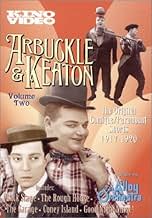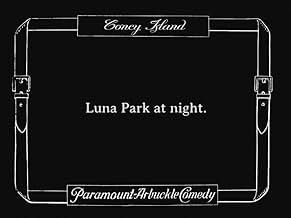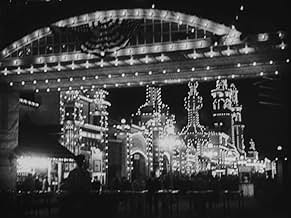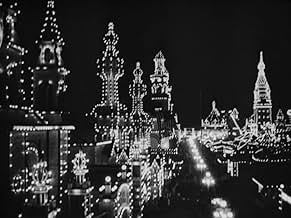Roscoe tries to dump his wife so he can enjoy the beach attractions. Buster arrives with Alice, who is taken away from him by Al, who loses her to Roscoe. Bathing beauties and Keystone Kops ... Read allRoscoe tries to dump his wife so he can enjoy the beach attractions. Buster arrives with Alice, who is taken away from him by Al, who loses her to Roscoe. Bathing beauties and Keystone Kops abound.Roscoe tries to dump his wife so he can enjoy the beach attractions. Buster arrives with Alice, who is taken away from him by Al, who loses her to Roscoe. Bathing beauties and Keystone Kops abound.
- Director
- Writer
- Stars
Buster Keaton
- Rival
- (uncredited)
- …
Joe Bordeaux
- Sledgehammer Man
- (uncredited)
- …
Jimmy Bryant
- Undetermined Role
- (uncredited)
Luke the Dog
- Dog Digging on Beach
- (uncredited)
Alice Lake
- Girl at Vanity Table
- (uncredited)
Alice Mann
- Pretty Girl
- (uncredited)
Agnes Neilson
- Fatty's Wife
- (uncredited)
Al St. John
- Old Friend of Fatty's Wife
- (uncredited)
- Director
- Writer
- All cast & crew
- Production, box office & more at IMDbPro
Featured reviews
This short comedy starts a little slowly, but it picks up as it goes along, and it has some good material. The "Coney Island" location is interesting, and makes for a variety of settings and scenery. Some of the material is a bit routine, at least in the first half, but it gets better towards the middle, and it has a typical Arbuckle/Keaton manic finale.
The comic trio of Keaton, Arbuckle, and Al St. John work well together as usual, and together they pull off some creative gags, making even the implausible ones work all right because of their timing and teamwork. Their romantic rivalries can get pretty silly, but are still funny.
The cast and the story use the setting to good advantage, and while there is nothing brilliant about it, this is a pretty good short comedy, and it is worth seeing for any fan of silent comedies.
The comic trio of Keaton, Arbuckle, and Al St. John work well together as usual, and together they pull off some creative gags, making even the implausible ones work all right because of their timing and teamwork. Their romantic rivalries can get pretty silly, but are still funny.
The cast and the story use the setting to good advantage, and while there is nothing brilliant about it, this is a pretty good short comedy, and it is worth seeing for any fan of silent comedies.
Considering the popularity of Roscoe Arbuckle, I have been disappointed by the few features I've seen him in. Coney Island is an OK 2 reeler, filmed at Coney Island in 1917. That's the major point of interest: Coney Island. Blah story that makes little sense is a series of badly done pratfalls on dry land and in the sea. Arbuckle dresses up as a fat lady but this gag goes nowhere. Buster Keaton is his rival for the interest of Alice Mann. Keaton (very early in his film career) is OK; Mann has weird hair. Worst of all is the grotesque Al St. John, as a bow-legged and toothless goon. He overacts and is repulsive. Agnes Neilson plays the wife (so why is Fatty chasing Mann?) and looks like a youngish Maude Eburne. Along with the plot less story, what's missing here (compared to Chaplin's and Lloyd's films of the same era) is precision. Arbuckle's many pratfalls are obviously staged and even when he's supposed to be getting hit, it never really looks like it--he just reacts. Keaton fares better here but has little to do. Also, while Chaplin, Lloyd, and Keaton all developed personae that fit their styles of comedy, Arbuckle has little to offer other than being fat. His character has no personality. Based on this lack and his 1921 "feature," Leap Year, I doubt that Arbuckle would have had much of a starring career as the 1920s progressed and film audiences grew more sophisticated.
8tavm
This was a mostly funny film of seeing Roscoe Arbuckle, Buster Keaton, and Al St. John, all of whom are competing for the same girl, hit and getting hit by various objects at Coney Island. I say mostly, because by the end, the short was almost running out of steam especially with Arbuckle's battle-ax of a wife continuing to appear. Arbuckle also dresses as a woman-having stolen another plus-size bathing suit from a female stranger because there wasn't a male suit for him-to hilarious effect especially when St. John flirts with him! The cop chase wasn't as funny but by that time I didn't care. So if you love knockabout silent slapstick comedy, I highly recommend Coney Island.
If you enjoy low comedy, i.e. low to the point of downright crudity, with plenty of slapstick, strenuous mugging, cross-dressing, and general anarchy -- Congratulations, you've come to the right place! The two-reel comedy known as "Coney Island" is a prime example of the sort of rough-housing that made Roscoe Arbuckle one of the top comedians of his era, second only to Chaplin in popularity. It's also a good example of the kind of comedy Arbuckle would soon outgrow, thanks at least in part to his newfound colleague Buster Keaton, who influenced Roscoe to employ more low-key and sophisticated comedic elements in his work. But that would come later. Here, in this early appearance, Buster overacts as shamelessly as everyone else, uncharacteristically grinning, laughing, and even indulging in Stan Laurel-style weeping. In addition to his prominent role as Alice Mann's escort, Buster doubles as mustachioed policeman in the movie's climax (he's the cop relieved of his trousers by Roscoe in the jail house), and also acts as Alice's stunt double in the water slide sequence. They sure did keep the guy busy.
Like so many comedies of its era, this one is built around escalating rivalries over a pretty girl. Initially, Buster is Alice's Coney Island date, but he loses her to creepy Al St. John -- how humiliating! -- who in turn loses her to Roscoe, who must first ditch his homely wife. After various shenanigans at the amusement park Roscoe and Alice wind up at the beach, where they must "hire" bathing suits, and this is where things turn a little strange. Seeing as how there are no men's swim trunks on hand large enough to fit him, Roscoe pilfers and dons a lady's XXX-tra large swimsuit instead. Alice, who doesn't seem to find this turn of events the least bit odd, helpfully finds him a curly wig to wear. Roscoe is in drag for the rest of the film, even when flirting with yet another girl who crosses his path. Somehow, when Arbuckle performs this kind of shtick it's not only amusing but strangely innocent, which is not to say there aren't some weird undercurrents. Anyhow, it all ends in wild mayhem at the jail house, leaving the viewer exhilarated and a little dazed.
This is primitive stuff all right, but it has a number of things in its favor. When the film was made the star comics were young and healthy, and had every reason to expect bright futures ahead. Their exuberance comes across strongly. (I happened to watch this film back-to-back with a short comedy called The Railrodder which Keaton made in Canada more than 45 years later; the contrast between the grinning, muscular 21 year-old Buster we see here and the grizzled, exhausted yet still game old man he would become was harrowing and poignant.) In this Coney Island romp everyone is buff, happy, and full of mischief, and they look like they're having a blast.
For that matter, Coney Island itself looks pretty spiffy here and boasts some really cool looking rides, and that's another plus. This film serves as a historical record of the legendary amusement park in its prime, and it features several great shots that have turned up in various documentaries about the place. The Coney Island of 1917 looks almost as clean and well maintained as the Disney theme parks of today, and this too is poignant: I happened to visit Coney Island myself a couple of years ago, and I'm sorry to say it's not such a cheery place anymore. The only way to visit that bright and happy Coney Island, vicariously anyway, is by seeing this film.
Like so many comedies of its era, this one is built around escalating rivalries over a pretty girl. Initially, Buster is Alice's Coney Island date, but he loses her to creepy Al St. John -- how humiliating! -- who in turn loses her to Roscoe, who must first ditch his homely wife. After various shenanigans at the amusement park Roscoe and Alice wind up at the beach, where they must "hire" bathing suits, and this is where things turn a little strange. Seeing as how there are no men's swim trunks on hand large enough to fit him, Roscoe pilfers and dons a lady's XXX-tra large swimsuit instead. Alice, who doesn't seem to find this turn of events the least bit odd, helpfully finds him a curly wig to wear. Roscoe is in drag for the rest of the film, even when flirting with yet another girl who crosses his path. Somehow, when Arbuckle performs this kind of shtick it's not only amusing but strangely innocent, which is not to say there aren't some weird undercurrents. Anyhow, it all ends in wild mayhem at the jail house, leaving the viewer exhilarated and a little dazed.
This is primitive stuff all right, but it has a number of things in its favor. When the film was made the star comics were young and healthy, and had every reason to expect bright futures ahead. Their exuberance comes across strongly. (I happened to watch this film back-to-back with a short comedy called The Railrodder which Keaton made in Canada more than 45 years later; the contrast between the grinning, muscular 21 year-old Buster we see here and the grizzled, exhausted yet still game old man he would become was harrowing and poignant.) In this Coney Island romp everyone is buff, happy, and full of mischief, and they look like they're having a blast.
For that matter, Coney Island itself looks pretty spiffy here and boasts some really cool looking rides, and that's another plus. This film serves as a historical record of the legendary amusement park in its prime, and it features several great shots that have turned up in various documentaries about the place. The Coney Island of 1917 looks almost as clean and well maintained as the Disney theme parks of today, and this too is poignant: I happened to visit Coney Island myself a couple of years ago, and I'm sorry to say it's not such a cheery place anymore. The only way to visit that bright and happy Coney Island, vicariously anyway, is by seeing this film.
New York City's beach-side Coney Island amusement park is the setting. Roscoe "Fatty" Arbuckle plays in the sand with inattentive wife Agnes Neilson. Fatty leaves her and goes to enjoy the rides and attractions at Luna. Fatty's friendly rivals Buster Keaton and Al St. John are there, causing laughter. The three men vie for the attentions of pretty Alice Mann. Fatty's yen for women's clothing increases the merriment and a few Keystone Kops later join in the fun. The cast is in good form, with the men famously physical. Keaton's stunts are the most daring. He also cries and laughs herein, well before his character's non-emotional "stone face" was cemented. This two-reel short seems cobbled, but is recommended more for its cast, setting and physical comedy.
****** Coney Island (10/29.1917) Roscoe Arbuckle ~ Roscoe 'Fatty' Arbuckle, Buster Keaton, Al St. John, Agnes Neilson
****** Coney Island (10/29.1917) Roscoe Arbuckle ~ Roscoe 'Fatty' Arbuckle, Buster Keaton, Al St. John, Agnes Neilson
Did you know
- TriviaThe Witching Waves ride consisted of a large oval course with a flexible metal floor. The floor itself did not move but an undulating wave, produced by hidden reciprocating levers, propelled two seated scooter-style cars which could be steered by the riders. It was invented by the same man who also invented the revolving door, Theophilus Van Kannel.
The ride can also be seen in the silent movie "Speedy" starring Harold Lloyd.
- GoofsThe first title screen wrongly identifies Coney Island's Luna Park as 'Luma Park'. At 00:03:52 the entrance to Luna Park is clearly seen.
- Quotes
Bathing suit renter: [to Fatty] We can't fit you, hire a tent.
- Alternate versionsIn 2005, Laughsmith Entertainment, Inc. copyrighted a 25-minute version of this film, with a new piano music score composed and performed by Philip Carli.
- ConnectionsFeatured in The Great Stone Face (1968)
Details
- Runtime25 minutes
- Sound mix
- Aspect ratio
- 1.33 : 1
Contribute to this page
Suggest an edit or add missing content

Top Gap
By what name was Fatty à la fête foraine (1917) officially released in Canada in English?
Answer

























